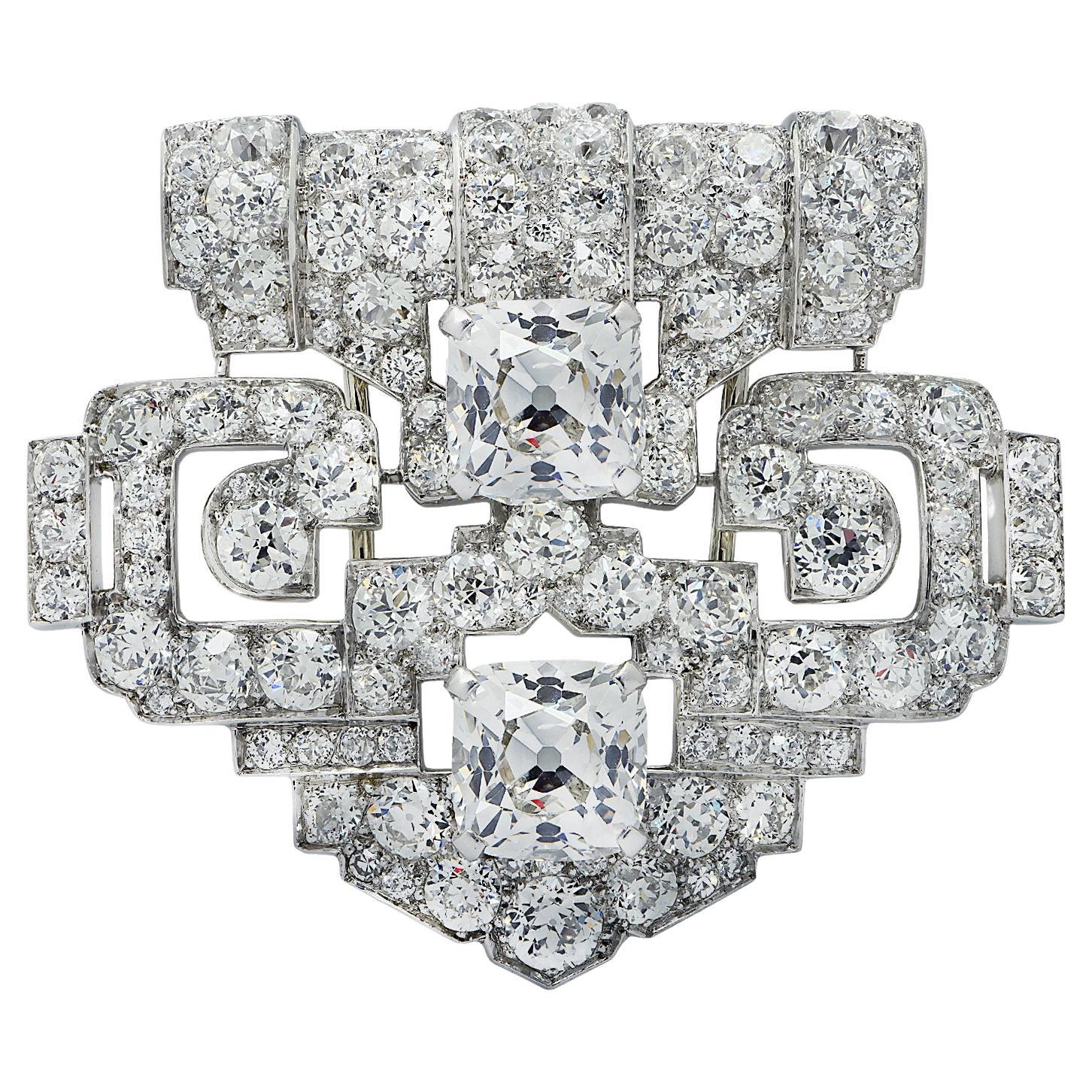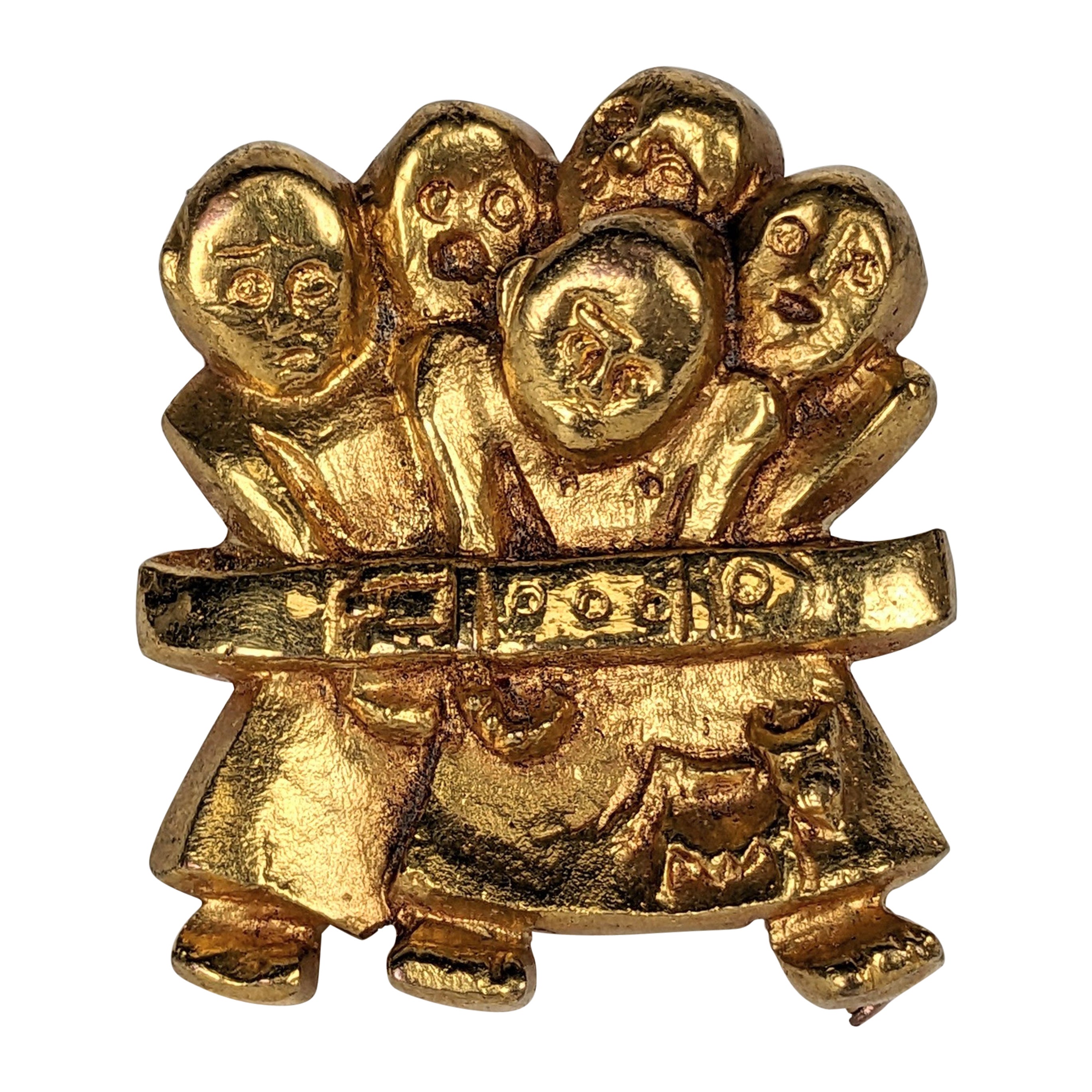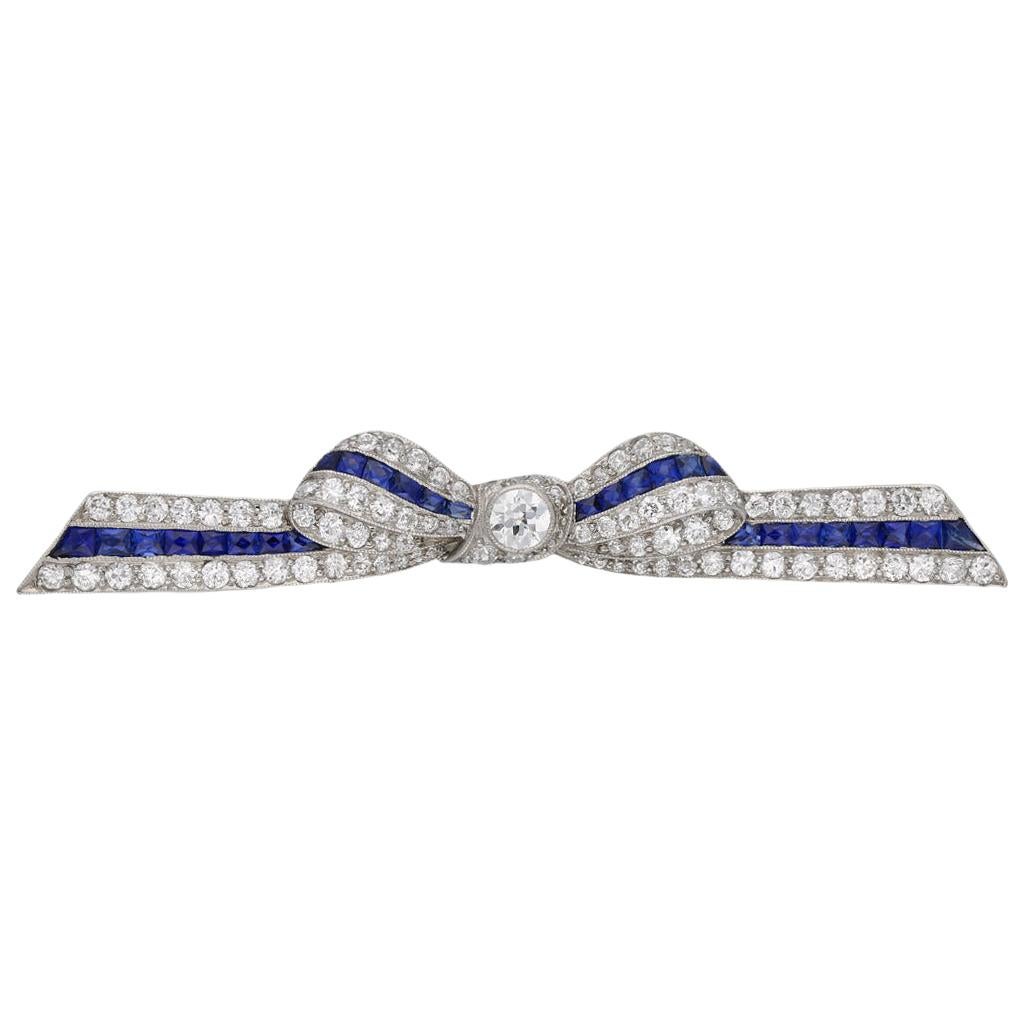1938 ElsaSchiaparelli CouturePagan DeposeFrance FeatherCrystalGold Bird Brooch
About the Item
- Creator:
- Metal:Gold,Yellow Gold,Gilt Metal
- Stone:Crystal
- Stone Cut:Mixed Cut
- Weight:4 g
- Dimensions:Width: 1 in (25.4 mm)Length: 2.5 in (63.5 mm)
- Place of Origin:France
- Period:1930-1939
- Date of Manufacture:1938
- Condition:Wear consistent with age and use.
- Seller Location:Chicago, IL
- Reference Number:1stDibs: LU3244222404982
Elsa Schiaparelli
From her signature color Shocking Pink to her collaborations with Surrealist artists, the boldly original Elsa Schiaparelli transformed fashion with her haute couture house from the late 1920s to the early ’50s. Experimenting with elements like trompe l’oeil images and colorful visible zippers, the Italian designer instilled a provocative avant-garde artistry in her clothing and accessories, including those created with Salvador Dalí, such as the lobster dress and a hat shaped like a shoe.
Born in Rome, Schiaparelli was a rebellious child who grew up among the city’s intellectual elite. She had a voracious appetite for reading and became interested in ancient cultures, astronomy and world religions. Schiaparelli studied philosophy at the University of Rome, and after publishing a collection of poems on love and sensuality that so mortified her conservative parents that they tried, unsuccessfully, to confine her to a Swiss convent, she left for London.
A quick marriage to Count Wilhelm de Wendt de Kerlor brought her to New York, but it would be in Paris following her divorce that Schiaparelli embraced her artistic passions. She moved to the French capital city in 1922 with her young daughter and happened to meet master couturier Paul Poiret, who loaned the stylish Schiaparelli his clothes, sparking her own fashion interests.
Schiaparelli opened her modest atelier in Paris and debuted her first collection of knitwear in 1927, and later that year, she designed a black-and-white pullover hand-knit wool sweater featuring a trompe l’oeil bowknot that captured the attention of the fashion world. Vogue called it “an artistic masterpiece.” The success led to her moving her house to 21 Place Vendôme in 1935 where thousands of garments were produced each year.
Schiaparelli’s knitwear collections were later accompanied by revolutionary swimsuits and other clothing and accessories. Her inventive designs would include culottes — a radical statement in the 1930s when women still could cause a scandal by wearing pants — as well as printed fabric, such as the 1938 Tears dress with a print designed by Dalí making it appear as if the evening gown had been savagely ripped.
Schiaparelli was among the first designers to use materials like rayon and Lurex as well as explore wrap dresses and transparent raincoats. She also introduced unisex fragrances and brought her artistic partnerships into jewelry, such as bronze brooches made with Alberto Giacometti and fur-lined bracelets with Méret Oppenheim. As she wrote in her 1954 autobiography Shocking Life, women should “dare to be different.”
Despite her acclaim, her shop closed in 1954 after a tumultuous time during World War II. By then, fashion had moved on with Christian Dior's New Look, and the closure of Schiaparelli's business coincided with a comeback mounted by Coco Chanel, her archrival in the early days.
In 2006, Italian businessman Diego Della Valle acquired the brand and its archives, and the Maison Schiaparelli was reopened in 2012, back at 21 Place Vendôme where Schiaparelli's fearless and enduring work began.
Find vintage Elsa Schiaparelli hats, evening dresses and other clothing and accessories on 1stDibs.
- ShippingRetrieving quote...Ships From: North Adams, MA
- Return PolicyA return for this item may be initiated within 1 day of delivery.
- Couture CocoChanel Byzantine ThePurpleHeart PearlAmethystQuartz GoldMedallionBy ChanelLocated in Chicago, ILDuring the ArtDeco period when Gabriel "Coco" Chanel was at her peak as a Parisian couture fashion-designer in the early 1930s, this antique one-of-a-kind handcrafted gem-fringed and gilt-chain medallion brooch with trombone clasp was commissioned to accessorize one of her clothing designs. Marked only "FRANCE" like some early 1930s Chanel couture jewelry (without a brand stamp until the 1950s), its artistic origin is most likely from ornate organic-form sketches by her favorite parurer Fulco di Verdura. The Sicilian duke began creating fabric patterns for Chanel in 1927, which shortly expanded to fine jewelry beginning with custom pieces for herself. These include the iconic Byzantine-influenced gem-adorned cuffs referencing the Maltese military-cross, which the French designer can often be seen wearing in circa-1930s photos. This bright yellow-gold brooch suits goldsmith Verdura's early anti-Art-Deco aesthetic that was considered a radical departure from 1920s silver-tone jewelry, which otherwise featured linear geometric designs or figurative representation. The softly-shaped deconstructed gem-bouquet mixes amethyst and rose-quartz beads with natural Keshi pearls and intricate tiny gilt leaves, which are wired to a Baroque-motif open-work frame that dangles another gem surrounded by a thick gilt-rope halo. Notably, Verdura is credited with re-introducing since Victorian times the rope motif to jewelry. Since 1930, Verdura's unique style was influenced by travels with Chanel to explore Byzantine art, Baroque architecture, and exotic flora-and-fauna among his native Italian aristocratic estate. The legendary fashion-editor Diane Vreeland and American entertainment-stars were among the first Chanel clients to acquire couture real-gem-adorned jewelry made by Verdura, while one of the two brooches treasured by Vreeland was titled "Theodora". See our photo of the Byzantine mosaic of Empress Theodora, whose image wearing many teardrop pearls above her chest and surrounded by a golden halo seems to be the inspiration for this brooch. As one of the most important modern-design collaborations, Chanel's close relationship with Verdura lasted largely-undocumented years in Paris, until he launched his first outside jewelry venture with a Hollywood designer-boutique after emigrating to the United States in 1934. By 1939 as a financially-backed in-demand goldsmith, he founded the namesake jewelry-company Verdura in NYC. After he retired in 1973, the brand continued to operate without him with different owners. Given the duo's designs that played with historic and military references, Chanel's couture commission for this purple medallion may have been sparked in the early 1930s when the internationally-new...Category
Vintage 1930s French Brooches
MaterialsAmethyst, Pearl, Quartz, Gold, Gilt Metal, Yellow Gold
- Artist BertoiaStyle Hammered SterlingSilver SquiggleSpiral UndulatingWire BroochLocated in Chicago, ILThis modern mid-century abstract three-dimensional unsigned brooch is a single hand-hammered sterling-silver wire that was shaped by an artist into an undulating squiggle that ends i...Category
Early 20th Century American Modern Brooches
MaterialsSterling Silver
- 1994 Smithsonian ModernArt LavaRock Sparkling SterlingSilver EyeShaped BroochBy ContemporaryLocated in Chicago, ILLike the pendant collected by the Smithsonian American Art Museum, this bezel-set lava rock was handcrafted as a modern sterling silver brooch by studio-artist Joan Parcher...Category
1990s American Artist Brooches
MaterialsOther, Sterling Silver
- ArtDeco c1925 Bakelite TriColor RedBlueGreen Carved Ribbon Bow BrassPinBroochLocated in Chicago, ILAntique ArtDeco-period Bakelite rare three-color ribbon bow hand-blended-and-carved brooch. Given the colors, narrow style, texture and affixed brass pin...Category
Vintage 1920s Unknown Art Deco Brooches
MaterialsBrass
- MiriamHaskell 1930s FrankHess TripleSeashell RussianGilt Flora WoodLeaf BroochBy Frank Hess for Miriam HaskellLocated in Chicago, ILThis early Miriam Haskell lacquered-shell and brass-decorated clip brooch was created by Frank Hess, her first designer since 1926. The 1930s brooch features three seashells supporti...Category
Vintage 1930s American Baroque Revival Brooches
MaterialsGold, Base Metal, Brass, Gilt Metal
- Antique Art&Crafts FiligreeGoldFill ScrollingTwisted DanglingHearts Shell BroochLocated in Chicago, ILEpitomizing the organic subjects and hand-craftsmanship spanning the Arts-&-Crafts to Art-Nouveau movements that were led in The United States by Louis Comfort Tiffany, this gifted o...Category
Antique Late 19th Century American Arts and Crafts Brooches
MaterialsChalcedony, Coral, Turquoise, Gold-filled
- Cartier New York GIA Certified 11.24 Carat Old Mine Cushion Diamond BroochBy CartierLocated in Miami, FLMagnificent Cartier Art Deco Platinum and Diamond Brooch featuring a matching pair of important Old Mine Cut Diamonds weighing 5.60 carats and 5.64 carats. Both accompanied by a GIA report stating that they are H color VS1 and H color VS2 clarity. This brooch comes with an Expertise letter from IAJA (international Antique Jewelers...Category
Vintage 1930s American Art Deco Brooches
MaterialsDiamond, Platinum
- Carved Coral Buddha Pendant in 18k Gold Set with Diamonds, Emeralds and RubiesLocated in Honolulu, HIMAGNIFICENT large vintage Buddha pendant brooch in 18K yellow gold. This gorgeous pendant features a stunning Buddha carved in natural coral set...Category
Late 20th Century Unknown Pendant Necklaces
MaterialsCoral, Diamond, Emerald, Ruby, 18k Gold
- Line Vautrin "La Manif" Gilt Bronze BroochBy Line VautrinLocated in New York, NYGilt brooch by Line Vautrin (1913-1997), circa 1945-46. The design is known as ...Category
Vintage 1950s French Artisan Brooches
MaterialsBronze, Gilt Metal, Gold Plate, Brass
- Vintage Ruby Onyx and Diamond Classic Car BroochLocated in London, GBHere we have a superb vintage brooch. The piece has been crafted from 18ct yellow gold into the shape of a classic car from the 1930s. Automobiles of the 1930s exhibited many notable...Category
Vintage 1930s Brooches
MaterialsDiamond, Onyx, Ruby, Gold, Yellow Gold, Enamel
- Marcus & Co. Sapphire and Diamond Bow Brooch, American, circa 1935Located in London, GBSapphire and diamond bow brooch by Marcus & Co, American, circa 1935. A yellow gold and platinum bow form brooch set with one central row of twenty eig...Category
Vintage 1930s American Art Deco Brooches
MaterialsDiamond, Sapphire, Platinum
- John Brogden Shell Cameo Brooch and Earrings, English, circa 1870By John BrogdenLocated in London, GBAntique shell cameo brooch and earrings by John Brogden, English, circa 1870. A yellow gold suite of jewellery, the brooch composed of a horizontally situated oval Bull’s Mouth shell cameo of the Greek goddess Selene riding a serpentine dragon in a rubover collet setting, encircled by a conforming frame of gold beading and twisted gold wire punctuated with four gold palmette form plaques engraved and decorated with dark blue enamel and placed at the cardinal points, the reverse mounted with a hinged pin and scroll clasp, the earrings each composed of a vertical oval Bull’s Mouth shell cameo engraved with a bust length portrait of Selene with crescent-set headdress, encircled by a conforming frame matching that of the brooch with the addition of a pendant decoration composed of a horizontal bar of gold beading and twisted gold wires suspending gold link chains graduated from centre and ending in conical gold elements, the reverses mounted with French wire fittings, all in a fitted red leather case, the interior marked ‘FIRST CLASS PARIS MEDAL/ 1855.1867.1851/ PARIS FIRST CLASS & LONDON PRIZE MEDALS/ JOHN BROGDON/ Goldsmith/ MANUFACTORY/ 16, Henrietta St. Covent Garden/ London’. The cameo—defined as a gem, usually either a mineral or a shell, upon which a design has been carved in relief—is believed to have originated in Hellenistic Greece, during the third century BC. These miniature sculptures, at that time confined to the medium of hardstone, are thought to have been made with the primary purpose of personal adornment. The same practice of mounting cameos in jewellery was then continued by the Ancient Romans, and they are known to have been worn by many a Roman emperor. After the fall of Rome the fashion for cameos went into a decline, until it was again revived during the Renaissance period, brought about by a keen interest in the ancient world. At this time both antique and contemporary cameos were mounted in jewellery, as well as collected as objet d’art. The art of cameo cutting was revived in Italy, where it would remain a centre for the coming centuries. Again there was a lull in interest in carved gemstones, until the Neoclassical revival of the eighteenth century, largely stimulated by the discoveries of the ancient Roman cities of Pompeii and Herculaneum. As with the Renaissance, antique specimens were generally prized over modern cameos, and the worldliest men in Europe held them among their collections of art and antiques. That said, carving centres in Rome and Torre del Greco (near Naples) in Italy were established in response to the demand of the Grand Tourists, who travelled to Italy and Greece to become educated in the wonders of the ancient world. It was at this time that shell cameos, mostly made in Torre del Greco due to its proximity to the sea, became more popular, owing to the relative ease in carving shell over hardstone. In addition to Rome, hardstone cameos also became a specialty of Idar Oberstein, Germany, which had a long history with both the gem mining and cutting trade. In a shift away from the collector’s cases of the previous century, the nineteenth century saw a strengthening in the fashion for wearable cameos. After the Empress Josephine donned a cameo-set suite of jewellery at the coronation of Napoleon in 1804, cameo jewellery became all the rage. Napoleon played a further hand in promoting the art by establishing a gemstone carving school in Paris, inspired by his appreciation for the arts of the ancient world. By the mid-nineteenth century shell cameos, in part due to their lightness compared with hardstone cameos, were the height of fashion. Large shell cameos as well as hardstone cameos were set into contemporary mounts, often as suites of jewellery. Some of the best cameos of the nineteenth century—carved by a select group of recognized carvers—were set into revivalist mounts, corresponding to the subject matter. In Victorian England cameo jewellery was particularly prized, due in part to the fact that the Queen owned and wore a number of cameo jewels. One example which can often be seen in official portraits is the Badge of the Order of Victoria and Albert, carved by Tommaso Saulini of Rome, who also produced cameos for the maker of the present suite, John Brogden. To meet demand some carvers set themselves up in London, including William Schmidt, a German carver from Idar Oberstein, who produced cameos for top London jewellers, including Brogden, Carlo Giuliano and Child & Child. In fact, Schmidt purports to have been the first to carve cameos out of opal, which Brogden reportedly displayed in the Paris Exhibition of 1878. An extant example, now in the collection of the British Museum, was set by the Giuliano firm. Regarding subject matter, cameos throughout time have been largely figural, from bust length profile portraits to scenes with multiple full-length figures, and sometimes animals. Ancient Greek and Roman cameos often depicted mythological scenes as well as contemporary figures. During the Renaissance, mythological scenes were popular, often taken directly from ancient sculpture, as well as portraits of notable contemporary figures. During the eighteenth and nineteenth centuries, due to the revivalist styles, both Renaissance and Classical subjects were copied and set into matching (and sometimes unmatching) revivalist mounts. From the Renaissance through the Victorian era, being able to recognize the source of the carving in a cameo was a mark of erudition, revealing in the wearer knowledge of Classical art. As mentioned, the present cameo parure...Category
Antique 1870s English Victorian Brooches
MaterialsYellow Gold
Recently Viewed
View AllRead More
You Saw It at the Met Ball. Here’s What Camp Fashion Is Really About
This year's Costume Institute exhibition is all about embracing the eccentric.
The Met’s Latest Blockbuster Tells a Powerful Story through 230 Jewels
A captivating show at the Manhattan museum explores how jewelry has ornamented the body through the millennia — and redefines it as high art.






